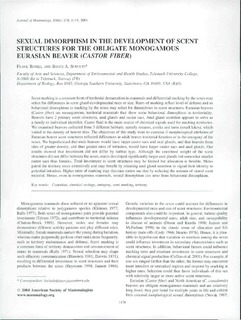Sexual dimorphism in the development of scent structures for the obligate monogamous Eurasian beaver (Castor fiber)
Journal article, Peer reviewed
Permanent lenke
http://hdl.handle.net/11250/2438076Utgivelsesdato
2004Metadata
Vis full innførselSamlinger
Originalversjon
Journal of mammalogy 85(2004) No. 6, p. 1138-1144 http://dx.doi.org/10.1644/BPR-106.1Sammendrag
Scent marking is a common form of territorial demarcation in mammals and differential marking by the sexes may select for differences in scent gland developmental rates or size. Rates of marking reflect level of defense and so behavioral dimorphism in marking by the sexes may select for dimoriihism in scent structures. Eurasian beavers (Castor fiher) are monogamous, territorial mammals that show some behavioral dimorphism in territoriality. Beavers have 2 primary scent structures, anal glands and castor sacs. Anal gland secretion appears to serve as a family or individual identifier. Castor fluid is the main source of chemical signals used for marking territories. We examined beavers collected from 3 different habitats, namely streams, creeks and tarns (small lakes), which varied in the density of beaver sites. The objectives of this study were to examine if morphological attributes of Eurasian beaver scent structures reflected differences in adult beaver territorial function or in the ontogeny ofthe sexes. We hypothesized that male beavers would have larger castor sacs and anal glands, and that beavers from sites of greater density, and thus greater rates of intmsion, would have larger castor sacs and anal glands. Our results showed that investment did not differ by habitat type. Although the combined weight of the scent structures did not differ between the sexes, males developed significantly larger anal glands but somewhat smaller castor sacs ihan females. Total investment to scent structures may be limited but allocation is flexible. Males patrol the terrilttry more extensively and may benetit by releasing anal gland sccrelion to signal their identity to potential intruders. Higher rates of marking may decrease castor sac size by reducing the amount of stored scent material. Hence, even in monogamous mammals, sexual dimorphism can arise from behavioral dimorphism.
